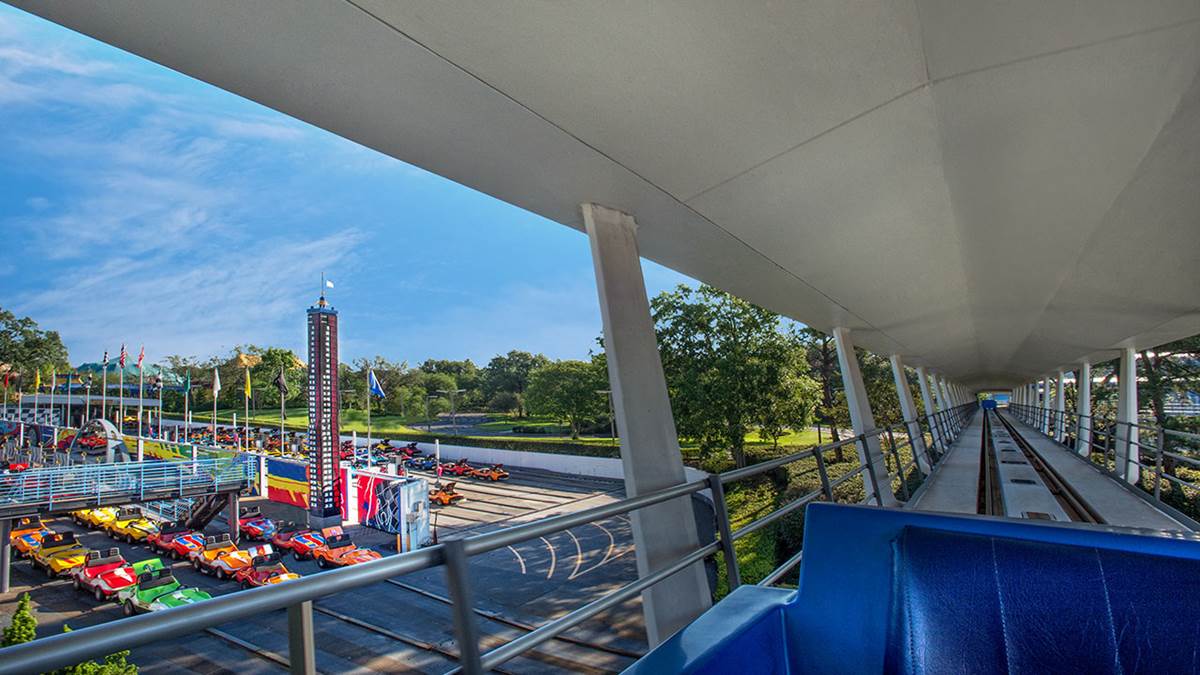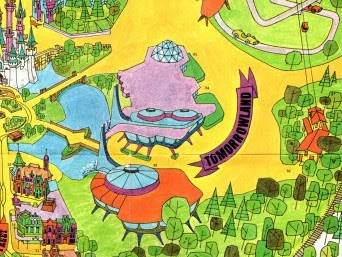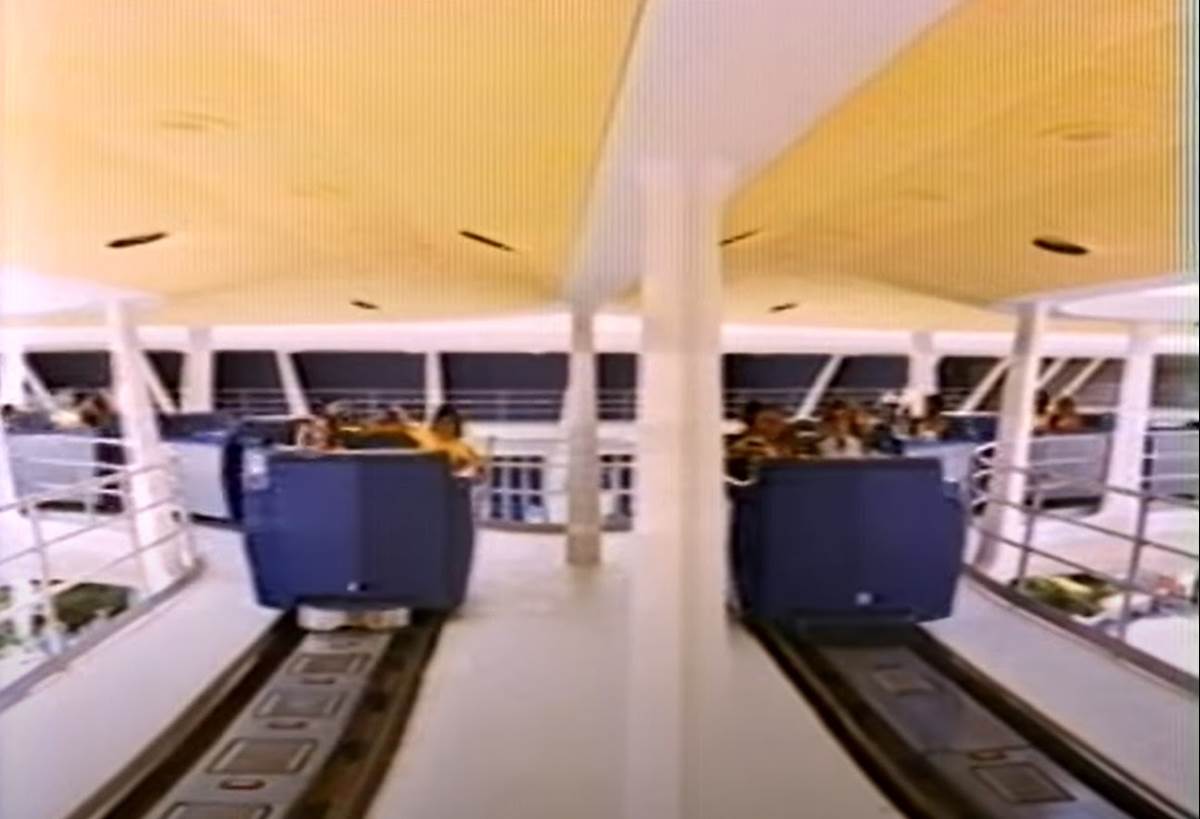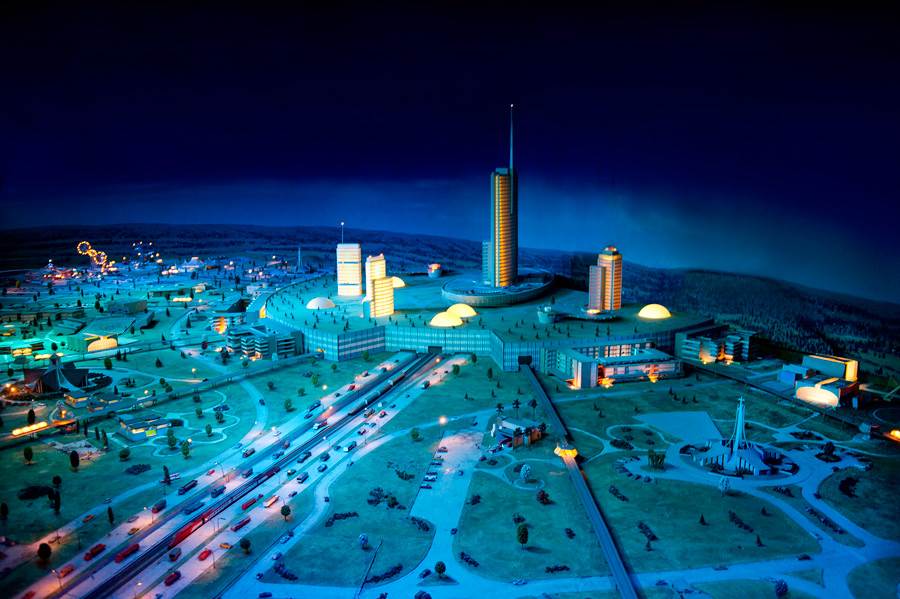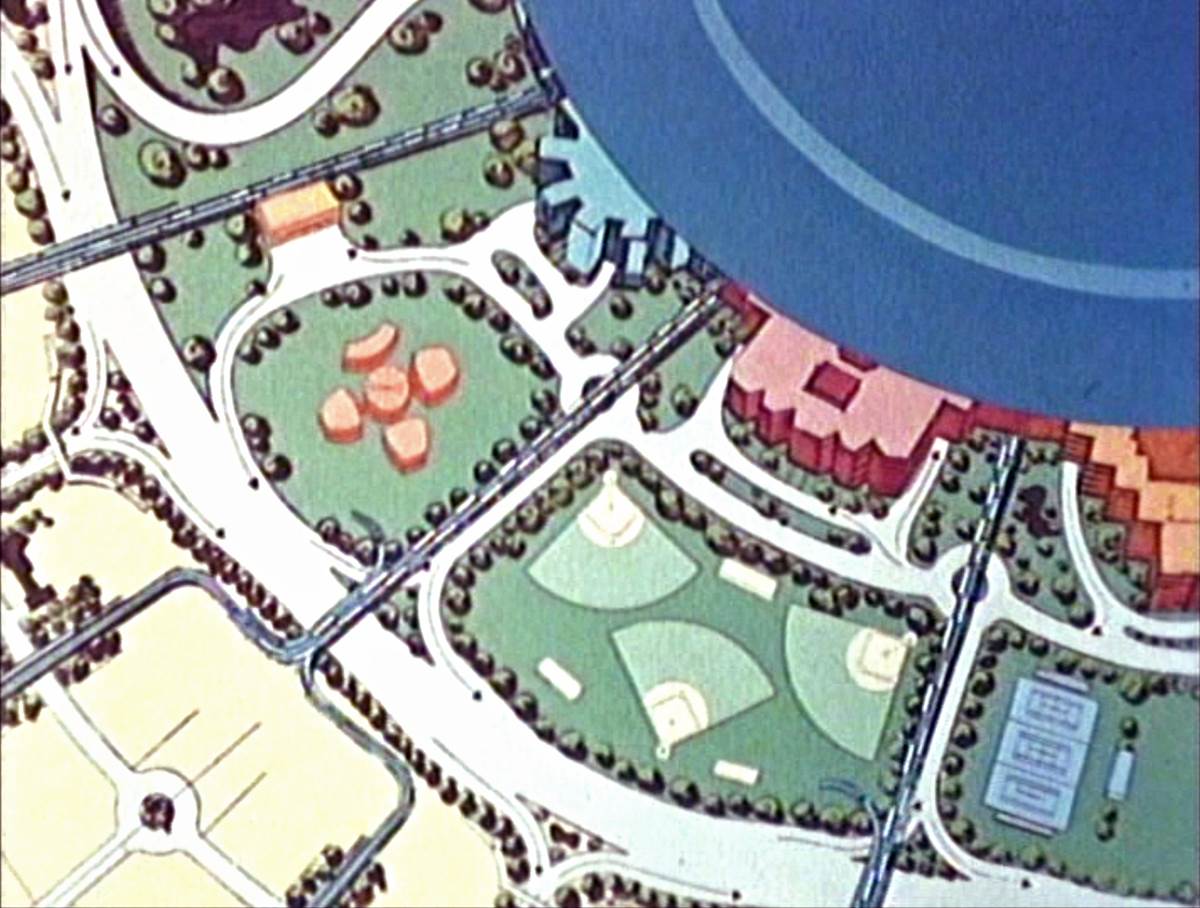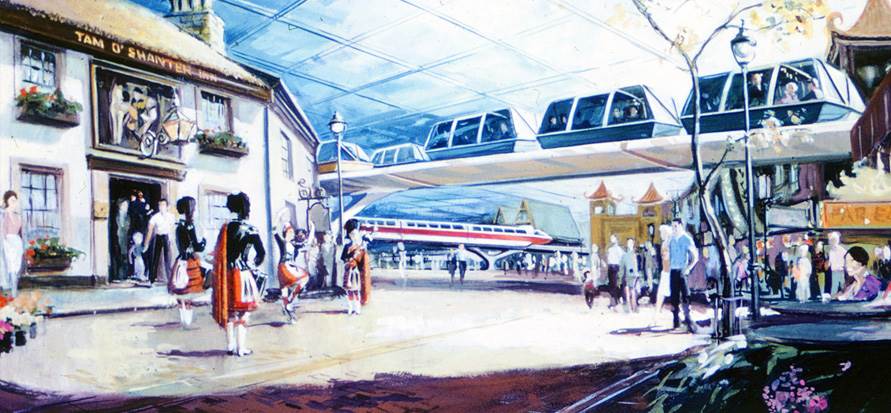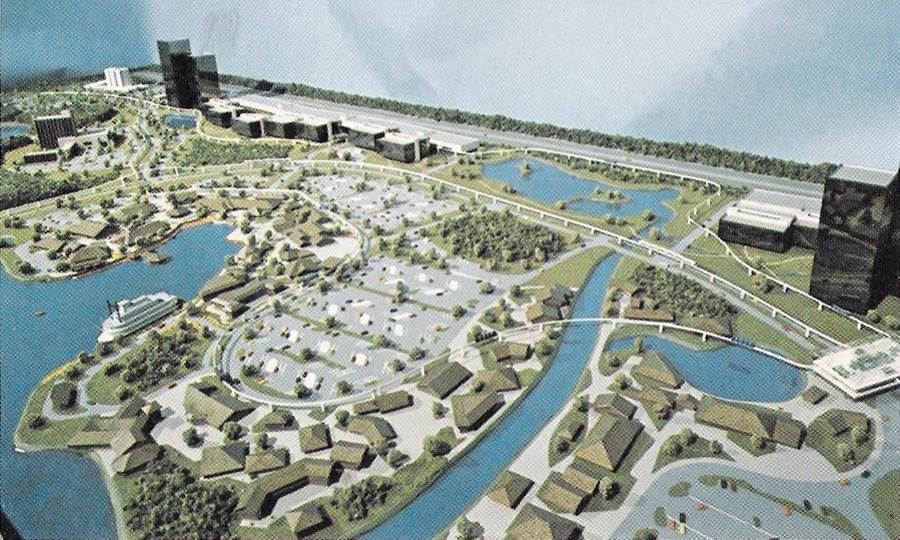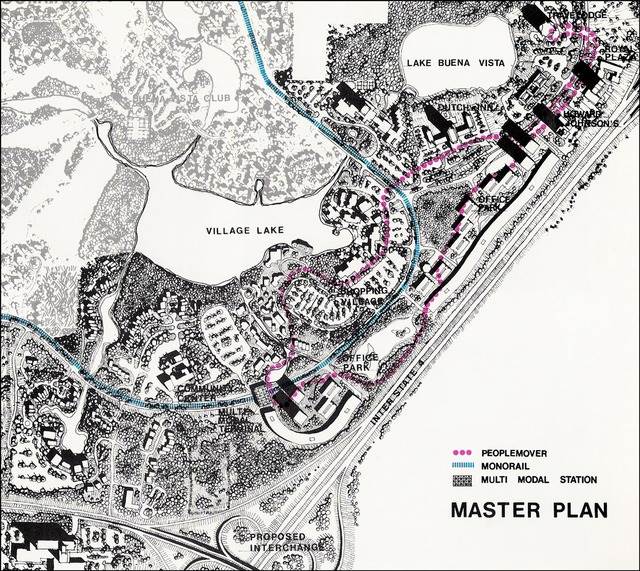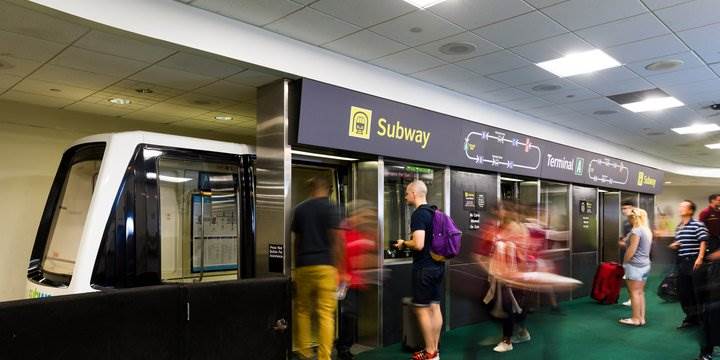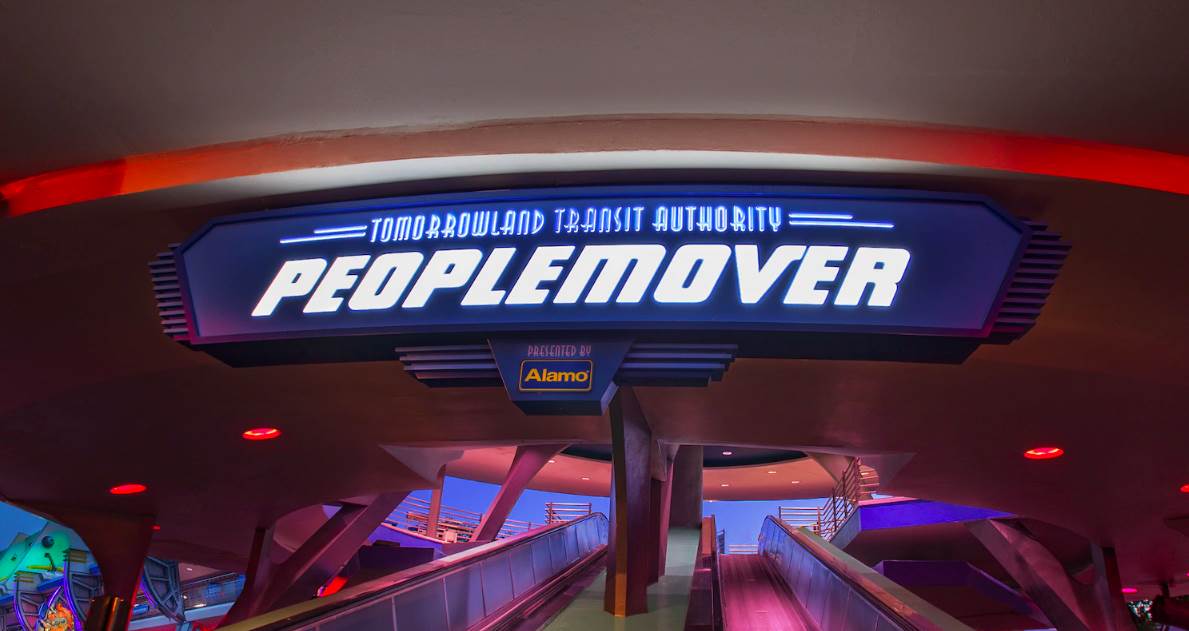45 Years of the WEDway Peoplemover: A Nerd Rant
It was forty-five years ago today that guests of Walt Disney World’s Magic Kingdom could experience a piece of technology for the first time that had barely been seen before, so climb aboard with me for a look at the nearly half-a-century of magnetic transportation.
Let me stop you before you get too far. No, the WEDway Peoplemover did NOT open with the park when the Magic Kingdom opened in 1971. In fact, it wasn’t until 1975 that the Tomorrowland infrastructure as we know it today took shape. That said, the Peoplemover was always planned for Tomorrowland in the Magic Kingdom. As the buildings were added and took shape as the land grew, a second floor concourse was included so the Peoplemover could traverse the land EVENTUALLY. If you were at the park in the early days, you would see the track concourse jutting out of buildings half-finished with just an endcap. The RocketTower station as we know it today, however, was never part of that plan. The station was originally going to be in the middle of the Space Port attraction, with an extended track similar to that of Disneyland’s Peoplemover going out past the Tomorrowland Speedway and back into Tomorrowland proper.
Space Port might not sound familiar to you because it never came to be. However, the concept lived on in the form of Space Mountain, which also opened in 1975. The mountain’s placement outside of the railroad berm would now be the extended portion of the Peoplemover track with the Tomorrowland Speedway extension cut short. The addition of If You Had Wings also altered the route just a bit. A maintenance bay that was planned for the area that was once Mickey’s Birthdayland/Starland/Toontown Fair and is now Storybook Circus was also scrapped and placed inside of Space Mountain. These changes would allow for a new circular standalone station in the center of Tomorrowland, similar to that of Disneyland’s and (just like Disneyland) the roof of this station would also become home to the Star Jets/Astro Orbitor. Final construction on the Peoplemover began in 1973.
Disneyland’s Peoplemover predated the Magic Kingdom’s, and utilized individual motors spinning tires along the track to propel the vehicles. As is evolution, the Magic Kingdom would instead use Linear Induction Motors (LIMs) to propel the vehicles whose bottoms are made of aluminum. To put it simply, electromagnets are placed along the track that both attract the vehicles to them and repel to push them away, some programmed to make the vehicles go slower for show scenes, and intensify to speed up. Ever been on the Peoplemover when it stops and find yourself moving backward, maybe even bumping another train? This is why.
There are 630 of the LIMs placed around the 4,600 feet of track. In theory, if 50% of the motors were to randomly shut down (IE not all the LIMs consecutively on one half of the journey), the attraction could still operate as normal.
After all was said and done and the 30 5 passenger trains were added to the track, the attraction opened on July 1st, 1975. Interestingly, the ride debuted as an E-Ticket attraction, though that didn’t last long and by 1976 was relegated to a D-Ticket. The legendary voice of Jack Wagner provided the narration of the tour high above and through the attractions of Tomorrowland. Attic space above the women’s restroom near (what was then) Tomorrowland Terrace (Now Cosmic Ray’s Starlight Cafe) was always meant for a diorama, and with the arrival of Walt Disney’s Carousel of Progress at the park (also in 1975), Progressland arrived with it and was cut into a small portion and occupies the attic space to this day. The first major change to the attraction came in 1985, when the Jack Wagner narration, as well the original sponsor, Edison Electrical Institute / America’s Investor-Owned electric companies were removed. In Wagner’s place was a new “commuter computer,” ORAC-1.
This remained relatively unchanged until the New Tomorrowland of 1994, when the most drastic change occurred to the WEDway Peoplemover as it became the Tomorrowland Transit Authority (TTA). Specifically, it became the Tomorrowland Transit Authority Metroliner Blue Line, as there were other fictitious routes as Tomorrowland (thematically) became a sort of intergalactic downtown environment. New scenes were added to interior corridors, and a whole new narration by Peter Renaday took over the route of the attraction. The TTA also helped tie the whole story of the new Tomorrowland together, identifying and sharing the backstories of the individual attractions subtly while also keeping the tradition of the high in the sky tour. Example: When passing The ExtraTERRORestrial Alien Encounter, the TTA narration wouldn’t point out simply the name of the attraction, rather that you were passing by the Tomorrowland Interplanetary Convention Center mentioning the current exhibitor, XS-Tech and their Teleportation machines.
Again, the attraction itself changed little from this point, only dropping and editing narration clips as the different Tomorrowland attractions came and went and new additions were added. This was the routine until 2009, when a completely new narration by Mike Brassell took over the Renaday narration. The new narration also included characters where applicable (Stitch at Stitch’s Great Escape, Buzz Lightyear at Buzz Lightyear Astro Blasters, etc.) returning more to the generic tour idea and dropping the folklore of the New Tomorrowland, but still retained the fun homages to Mr. Johnson and Mr. Morrow. In 2010, the ride’s official name changed to the Tomorrowland Transit Authority Peoplemover.
The attraction is a classic among fans, but for those truly obsessed with it they know it’s so much more than just a tour of Tomorrowland. Like its California predecessor (which has a long and drawn out history in its own right), the Peoplemover was an experiment in transportation technology, destined for more than just a theme park attraction.
When Walt Disney announced his Experimental Prototype Community of Tomorrow that was planned for the thousands and thousands of acres he purchased in Florida, he made a film that described how the new city would operate. Prominently featured as more localized transportation from a central hub, he showcased the WEDWay Peoplemover.
EPCOT the city as he saw it never came to be. Plans at the Walt Disney World Village (now Disney Springs) once also called for a monorail stop near where the Typhoon Lagoon entrance lies today, with a dedicated Peoplemover line that would take guests to the Shopping Village, Lake Buena Vista Golf Course, the hotels of Hotel Plaza Boulevard and the vacation homes that once stood where Disney’s Saratoga Springs Resort and Spa can be found today.
EPCOT as we know it also almost got its own Peoplemover that would run the stretch from Spaceship Earth toward World Showcase while traversing through either side of Communicore/Innoventions. A planned second level concourse that would line the exterior walls past the exhibits never came into fruition.
Now is it really considered experimental transportation if it only ever exists in these theme park environments? Some will say yes. Others have the case of one official WEDway Peoplemover that DID actually make it out of the theme park realm, and it still exists today, though possibly not for much longer. The George Bush Intercontinental Airport in Houston, Texas (IAH) swapped out their inter-terminal transportation system in 1981 and contracted a division of then WED, WED Transportation Systems, to do the job. The “Subway” as it is known, operates just like the Peoplemover in Tomorrowland with LIMs and automated trains. The one key difference to this version is that it actually stops at different stations and is an enclosed vehicle.
It is sad, but this system is considered outdated to many of the travelers who pass through the airport, and it reportedly takes passengers through security zones so they would have to once again go through the trying process that is an airport security checkpoint if connecting to another flight. In a 2012 – 2016 Capital Improvement Plan, it was stated that by the airport owners and airlines at the airport that they had determined that the cost of operating and maintaining the system is no longer viable. That was four years ago, and before the travel halts caused by COVID-19, so if you’re adamant, you might want to get to Houston (IAH) sooner than later.
Courtesy Fly2Houston
Or, you can do some work at the Capitol in Washington D.C. where a familiar looking subway system carries members of Congress to and fro. This one however, has a bit of a catch to it. At a certain point, WED Transportation and the WEDway Peoplemover exchanged hands and became part of Canada-based Bombardier. It was AFTER this that Bombardier was contracted to install the subway system at the Capitol. It operates eerily similar to the WEDWay Peoplemover we know and love, using the LIM technology, but also operates like the one at the Houston Airport where it physically stops and uses enclosed vehicles. The only real difference is that it does not TECHNICALLY have the WEDway name.
Courtesy BusinessInsider
Worry not though, the Tomorrowland Transit Authority Peoplemover is still at the Magic Kingdom and will be operating when the park reopens on July 15th. With the upcoming addition of Tron Lightcycle Run, guests to Tomorrowland may have noticed changes to the overall aesthetic of the land, and rumors have been circulating about the future of the Peoplemover. Not so much in its removal, but rather different rethemes to existing intellectual properties, with The Incredibles having been named more than a few times. For most Peoplemover fans (myself included), we don’t necessarily need a character driven themed adventure to jump on a piece of experimental transportation. We just like the ride as is, as it has been for forty-five years.



